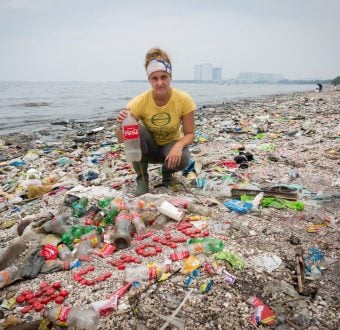Hewlett-Packard, which Greenpeace targeted last year for failing to meet its deadline for phasing out toxics in its products, deserves credit for the HP Compaq 8000f Elite Ultra Slim Desktop PC, the industry’s first Microsoft Windows based desktop to be free of brominated flame retardants (BFRs) and polyvinyl chloride (PVC) “from the wall to the mouse.” The HP computer earned the computer maker Greenpeace’s “Best In Show” award.
Samsung, however, continues to trail behind industry leaders like Apple and Sony by not following through on its promised phase-out of toxic chemicals in its products. With only its latest models of mobile phones free of toxic substances, it has set January 2011 as the deadline for eliminating them from new models of its notebooks and still has no definitive timeline for removing them from its TVs and household appliances Samsung’s antiquated technology and policies earned it the “Worst In Show” award.
Samsung, Dell, Lenovo, and LGE pick up penalty points in the Greenpeace Guide (1) for failing to follow through on a promised phase-out of toxic chemicals in their products. The majority of the companies in the Guide had pledged to remove toxic PVC vinyl plastic and brominated flame retardants (BFRs) (2) from their product range by the end of 2009, which would have meant a greater show of greener, toxic-free products for visitors to preview at the CES. But, for now, it’s a no show for these companies, who have delayed their phase-out to 2011 or beyond.
Several companies see their scores reduced in this edition of the Guide, with the bar being raised on hazardous substances. Having endorsed the precautionary principle, companies now need to actively support bans on PVC, BFRs and chlorinated flame retardants (CFRs) during the revision of the European Union’s Restriction of Hazardous Substances in Electronics Directive.
“Companies need to support legislative bans to ensure a consistent phase out of PVC and BFRs across all electronic products,” said Casey Harrell, Greenpeace International toxics campaigner. “Sony Ericsson and Apple are already calling on EU institutions to support such a ban. Other big players, such as HP and Dell – who have so far been silent – and Acer, need to ensure the ban is passed in the European Union parliament.”
Nokia leads the ranking with a score of 7.3. Sony Ericsson follows closely, and is the only company to score full marks on all the toxic chemicals criteria. In third place is Toshiba, but it risks losing points if it fails to meet its commitment to market new models of all its consumer electronics products that are free of PVC and BFRs by April 1, 2010. Philips comes in fourth place, while Apple rises from ninth place to fifth.
VVPR info: Daniel Kessler, Greenpeace Media Officer, USA Mobile +1 510 501 1779, email: [email protected] Casey Harrell, Greenpeace International Toxics Campaigner, based in San Francisco, USA Mobile: +1 415 307 3382, email: [email protected]
Notes: Please see www.greenpeace.org/ces for Greenpeace’s daily coverage of the CES. Photo and video are available at the following FTP: ftp://share.greenpeace.org login: gptv passw: deogheuz folder: 1001_CES_Vegas subfolder: DOCUMENTS subfolder: VIDEO 1. www.greenpeace.org/rankingguide 2. PVC contaminates humans and the environment throughout its lifecycle; during its production, use, and disposal it is the single most environmentally damaging of all plastics, and can form dioxin, a known carcinogen, when burned. Some BFRs are highly resistant to degradation in the environment and are able to bio-accumulate (build up in animals and humans). With the growth of electronic waste, workers who deal with e-waste and the wider community are at significant health risks. Burning of e-waste to recover valuable resources, as routinely takes place in the backyards of China, India and much of the South, can form dioxins. Eliminating the substances will decrease exposure and increase the recyclability and reusability of electronic products. http://www.greenpeace.org/international/campaigns/toxics/electronics/what-s-in-electronic-devices/bfr-pvc-toxic 3. http://www.environmentalleader.com/2009/12/08/cisco-reduces-ghg-emissions-by-40/

